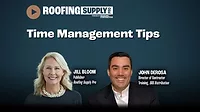Ten Tips for More Effective Sales Presentations
"You never get a second chance to make a first impression.” Will Rogers wasn’t a roofing salesperson, but if he were he would have made a great one. Creating a sales presentation what wins jobs is part art, part customer analytics and a pinch of discipline all rolled into one. To understand the importance of the sales presentation, we first need to look at how much money is spent on just getting the opportunity to give one.
Start by adding up all the money your company spends on marketing, advertising, sales salaries and sales related expenses such as gas, cell phone, computer, vehicle, etc. for an entire year. Now take that total number and divide it by the total number of leads you received during the same year. That is your cost per lead. Shocking isn’t it? The average range is between $75 and $150 per lead. When you look at it that way, the sales presentation becomes very important, or it’s money down the drain.
Now consider the fact that not all customers will meet with you to go over the presentation. Of course it’s a best practice to schedule estimates with all of the decision makers there with plenty of time to go over every part of the proposal. But let’s be realistic — many building owners will not give you the time. You’re not going to miss out on an opportunity just because the potential customer doesn’t want to meet, are you? And it’s getting worse. The way our society communicates is going digital. Text, instant messages, posts and e-mail are replacing the good old-fashioned conversation. How many times have you heard, “Can you just e-mail me the proposal?” The traditional sales presentation is becoming irrelevant. So now your presentation needs to connect with a potential customer without you even being there and also work when you do get the chance to go through the dog and pony show.
A new form of presentation is needed for a new breed of consumers. Jeffery Gittomer said it best when he stated, “People don’t like being sold, but they love to buy!” We all like a choice. We want the chance to compare and shop. It’s our job, as sales professionals, to give the customer what they want.
Here’s how to create a sales presentation for a new breed of customers:
1. Hit all media forms:Every customer is different and you need to speak their language in a way they are comfortable. Your sales presentation needs to be available:
• On your website
• In .pdf form for e-mail
• In .jpeg form for tablets
• Printed for in-person demonstrations
• In PowerPoint for web meetings
2. Include personal information: People like to buy from people they feel comfortable with. Include personal information about yourself and why you choose to work at the company you do. Talk about your passions. Show the potential customer that you are there to help them make a good decision.
3. Explain what the company is good at:Customers will try to avoid making a poor choice. This includes the company they go with. If you can prove that your company is the best for their job you’ll have a better chance of winning the project. Show proof of awards, letters of recommendation and special certifications that sets you apart from others.
3. Show the customer’s roof:Showing photos of their existing roof is a great way to showcase why your system will work better than what is there and helps avoid the simple, “We just want what we have.” In order to provide a solution you need to describe a problem. Using the customer’s roof drives it home and builds urgency.
4. Commit to production: Envision what it would be like if your company did the job. Talk about the steps you would take to protect the building from damage, staging of equipment, loading of materials, removal of the old system and photos you’ve taken to alert your team of special areas to protect. Pulling an EagleView report for all estimates gives a perfect visualization for the customer and your team to use.
5. Provide a step-by-step overview:Go through the entire process from beginning to end without getting specific is a great way to quickly educate the customer on roofing. It moves at a brisk pace and keeps the customer engaged. Avoid getting into too much detail. Use photos whenever possible over words. A typical shingle reroof should have about 20 steps and 40 photos.
5. Build in upgrades:Make optional upgrades appear as though it is standard or customary to choose them as if it were part of the normal process. This will make upselling more successful and more comfortable for your salespeople.
6. Build the roof:Now go back through and identify each step of the process where the customer has an option or upgrade to choose from. For each option list all of the options the customer has, even if your company doesn’t agree with that option. Showing the customer everything builds trust. It also allows you the opportunity to discredit other bidders by educating the customer on the key areas. Each option should have a quick overview comparing all of the choices and a more detailed explanation on the specific option you recommend. Some of the more popular categories are:
7. Include a bag of goodies:Have samples of all the choices and show the customer why your recommend one over the other. Let them feel the differences. If a picture is worth a thousand words, imagine what the real thing is worth.
8. Have the customer fill out an answer sheet:While going through the presentation, let customers mark down their choices. Rather than getting into exact pricing, simply state which option is the cheapest, middle of the road and most expensive without giving actual numbers. By letting the customer mark down their choices it makes them take ownership of their decision and builds confidence.
9. Provide a pricing matrix:After the answer sheet is filled out, apply pricing to each item. It’s important to have a grid sheet already computed with every option’s pricing prior to going over the presentation. This will improve presentation flow and avoid looking like arbitrary pricing you just came up with.
10. Exercise discipline: It’s not easy to have the discipline necessary to follow a sales process on every lead, but doing so increases your chance of success. The best part for managers and owners is that this gives your entire sales team a consistent base from which to work from and eliminates fragmentation. I suggest adopting the motto, “Every lead, every time.”
In the past when a customer asked us to e-mail them a proposal we would go out, measure, create a proposal and e-mail it. We found that in most cases the winning company was the one who had the lowest bid. With our new sales presentation, we are able to send the potential customer our Roofing Decider and have them pick out their roof for us to price. The Roofing Decider becomes a silent salesperson, educating the customer and helping eliminate competition. It has made a difference in our company and I hope these suggestions make a difference in yours. Check out www.kellyroofing.com for an example of how to build a sales presentation that works. If you would like to use our design for your company just contact me for a free copyright waiver. (Note: This offer is available for non-competing companies outside the state of Florida.)
This month’s homework is to identify options and upgrades in your company. Create a pricing matrix to work from so it’s easy to quickly fill in onsite. Gather samples of materials and build sales kits for each salesperson to use in demonstrations. Start putting it all together into a graphically pleasing presentation for all forms of media.
Next month’s Article will focus on training and recruiting.
Looking for a reprint of this article?
From high-res PDFs to custom plaques, order your copy today!





